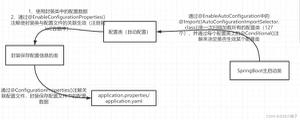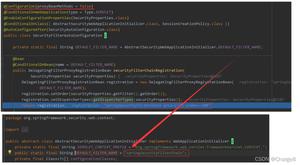Spring 中基于 AOP 的 @AspectJ注解实例
本文内容纲要:
- 1.第一步:倒入jar包,跟上个例子包是一样的- 2.第二步:创建三个类
- 2.2下面是 Student.java 文件的内容:
- 2.3下面是 MainApp.java 文件的内容:
- 3.第三步:创建bean文件(上面的头文件在上个例子当中有,这里就省略了)
@AspectJ 作为通过 Java 5 注释注释的普通的 Java 类,它指的是声明 aspects 的一种风格。通过在你的基于架构的 XML 配置文件中包含以下元素,@AspectJ 支持是可用的。
1.第一步:倒入jar包,跟上个例子包是一样的
- aspectjrt.jar
- aspectjweaver.jar
- aspectj.jar
- aopalliance.jar
2.第二步:创建三个类
2.1这里是 Logging.java 文件的内容。这实际上是 aspect 模块的一个示例,它定义了在各个点调用的方法。
1 package com.spring.aop2; 2
3 import org.aspectj.lang.annotation.AfterReturning;
4 import org.aspectj.lang.annotation.AfterThrowing;
5 import org.aspectj.lang.annotation.Aspect;
6 import org.aspectj.lang.annotation.Before;
7 import org.aspectj.lang.annotation.Pointcut;
8
9 @Aspect // 定义切面
10 public class Logging {
11 @Pointcut("execution(* com.spring.aop2.Student.*(..))") // 定义切点
12 private void selectAll() {
13
14 }
15 /**
16 * 定义通知方法
17 */
18
19 @Before("selectAll()")
20 public void beforeAdvice() {
21 System.out.println("----------beforeAdvice-----------");
22
23 }
24
25 @AfterReturning(pointcut = "selectAll()", returning = "retVal")
26 public void afterReturningAdvice(Object retVal) {
27 System.out.println("Returning:" + retVal.toString());
28 }
29
30 @AfterThrowing(pointcut = "selectAll()", throwing = "ex")
31 public void AfterThrowingAdvice(IllegalArgumentException ex) {
32 System.out.println("There has been an exception: " + ex.toString());
33 }
34
35 }
2.2下面是 Student.java 文件的内容:
1 package com.spring.aop2; 2
3 public class Student {
4 /**
5 * 定义学生类
6 */
7 private String name;
8 private Integer age;
9
10 public String getName() {
11 return name;
12 }
13
14 public void setName(String name) {
15 this.name = name;
16 }
17
18 public Integer getAge() {
19 return age;
20 }
21
22 public void setAge(Integer age) {
23 this.age = age;
24 }
25
26 public void printAdvice() {
27 System.out.println("name:" + name + ",age:" + age);
28
29 }
30
31 }
2.3下面是 MainApp.java 文件的内容:
1 package com.spring.aop2; 2
3
4
5 import org.springframework.context.ApplicationContext;
6 import org.springframework.context.annotation.AnnotationConfigApplicationContext;
7 import org.springframework.context.support.AbstractApplicationContext;
8 import org.springframework.context.support.ClassPathXmlApplicationContext;
9
10 public class Main {
11 /**
12 * Spring aop基于注解 配置文件springAop.xml
13 * author:
14 * mail:2536201485@qq.com
15 * 时间:
16 */
17 public static void main(String[] args) {
18 ApplicationContext applicationContext=new ClassPathXmlApplicationContext("spring_xml/springAop.xml");
19 Student student=(Student)applicationContext.getBean("Student");
20 student.printAdvice();
21 }
22
23 }
3.第三步:创建bean文件(上面的头文件在上个例子当中有,这里就省略了)
下面是配置文件 Beans.xml:
1 2 <!-- 开启注解 通过aop命名空间的<aop:aspectj-autoproxy
3 />声明自动为spring容器中那些配置@aspectJ切面的bean创建代理,织入切面-->
4 <aop:aspectj-autoproxy/>
5 <!-- 定义切面bean -->
6 <bean id="Logging" class="com.spring.aop2.Logging"></bean>
7
8 <!-- 配置bean -->
9 <bean id="Student" class="com.spring.aop2.Student">
10 <property name="name" value="张三"></property>
11 <property name="age" value="23"></property>
12 </bean>
让我们运行一下应用程序。如果你的应用程序一切都正常的话,这将会输出以下消息(其中包含了异常通知):

本文内容总结:1.第一步:倒入jar包,跟上个例子包是一样的,2.第二步:创建三个类, 2.2下面是 Student.java 文件的内容:, 2.3下面是 MainApp.java 文件的内容:,3.第三步:创建bean文件(上面的头文件在上个例子当中有,这里就省略了),
原文链接:https://www.cnblogs.com/ysource/p/12864818.html
以上是 Spring 中基于 AOP 的 @AspectJ注解实例 的全部内容, 来源链接: utcz.com/z/296781.html









